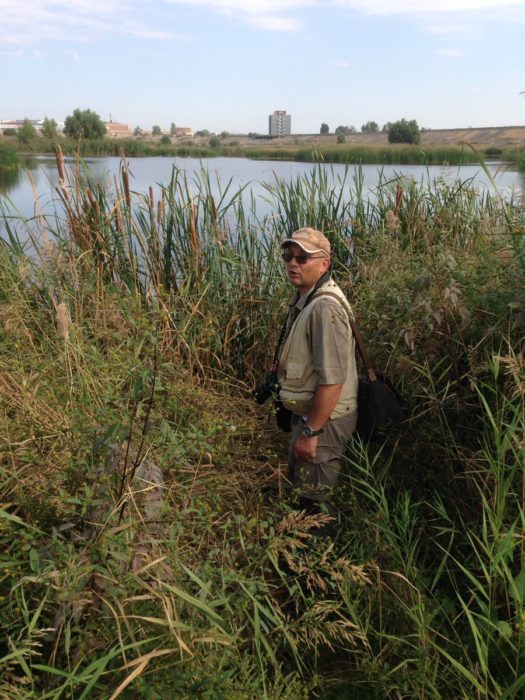21st September 2016
Vacaresti: A Wetland in Central Bucharest
On Sunday morning I headed to a small supermarket of the La doi Pasi chain at the base of one of the towers of Asmita Gardens residential complex, close to the canalised Dambovita river in the southern part of the Romanian capital. I was there to meet Dan Barbulescu, Director of the Vacaresti Natural Park Association, and Helmut Ignat, the wildlife photographer who has done much to raise public awareness of the ecological treasure which has developed quietly, unobtrusively, in an unexpected corner of the Romanian capital.

The park has its origins in an eccentric urban planning scheme of the end of the Ceausescu regime. A hundred and eighty nine hectares of land was surrounded by a concrete dyke, the few buildings on the site demolished, as part of a plan to create Lake Vacaresti as a component of a flood defence network which was to involve the bringing of the water to the capital from the Arges river, some 27 km away, via Lake Mihailesti. The network was never completed. Vacaresti was at one point partially and expensively filled by water pumped from the Dambovita river below, but with the collapse of the communist regime in 1989 the work was abandoned.
There were controversial plans at the time of the Nastase government to redevelop the site as an entertainment complex, but these came to nothing. And, in the meantime, behind its encircling concrete wall, the site lay forgotten. During this time something rather amazing was happening. Nurtured by natural springs on the site, the plant and animal world was re-conquering the place. In a landmark 2012 article in the Romanian edition of National Geographic, writer Cristian Lascu and photographer Helmut Ignat published a piece entitled ‘The Delta Between the Blocks’, which recorded the rich flora which had established itself in this wetland habitat, and the animal species which had made the place their home, including European otters, western marsh harriers and red-breasted geese. After a long campaign the site was accorded the status of a nature park in May this year, giving it important protection. Though the fisherman still to be spotted here have not it seems yet grasped the new rules governing the area.

We walked first around the top of the dyke, which has become an informal six kilometre jogging track, and then down the concrete slope to the much less visited space below. The noise of the city disappeared. And for lengthy stretches, walking through dense undergrowth, every visible sign that we were in a metropolis of two million people was gone too. Swans, egrets and cormorants swooped across the open water.
Gica has been living right in the centre of the park for eighteen years. He greeted us in a t-shirt matched with the trousers of a pinstripe suit and training shoes, and took us to his home, a canvas structure with electricity provided by a small generator. His nine children and four grandchildren clustered around. Cats and dogs prowled, mewed and barked. He scattered some corn on the ground and two pigs showed up. There were an impressive number of pigeons, who shared the family home. And, bizarrely, there was also a young film crew in the yard, making a documentary about Gica and his family. He makes his living fishing, collecting scrap metal from the site, and picking up recyclable plastic bottles, and is supportive of those working to preserve the park’s ecosystem. He proudly pointed out that his youngest children and grandchildren were attending school. Those children, meanwhile, were pulling our delighted son George around the yard in a plastic truck.

Dan and Helmut described their plans for the site. There were some key issues to resolve: including a government decision on the organisation which will administer the site. The park offers huge opportunities, for example as a centre of ecological education for the children of Romania’s capital, but there are challenges too, from littering to fire. The Vacaresti Natural Park Association has been establishing a range of international partnerships, including with the University of Arizona. And I was pleased to hear that UK connections are important to them. The London Wetland Center in Barnes, converted from disused Victorian reservoirs, and now both a major tourist attraction and important bird site, is seen as a model for the park. And the association has received encouragement from Wetland Link International, the organisation run by the UK-based Wildfowl and Wetlands Trust, which runs the London Wetland Center.
The Vacaresti Park covers almost the same surface area as Bucharest’s famous Herastrau Park, which is currently confronting some rather different challenges in reconciling the various demands upon it. Vacaresti is a worthy and important addition to the open spaces of the Romanian capital, and a remarkable example of what can happen when nature is left alone.
Your Excellency, Mr. Ambassador, thank you for your interest in supporting Bucharest to become a better place to live in for its inhabitants and an empowered, active and sustainable European capital. Without partnerships involving all stakeholders – public sector, private sector, civil society – the path would be bumpier.